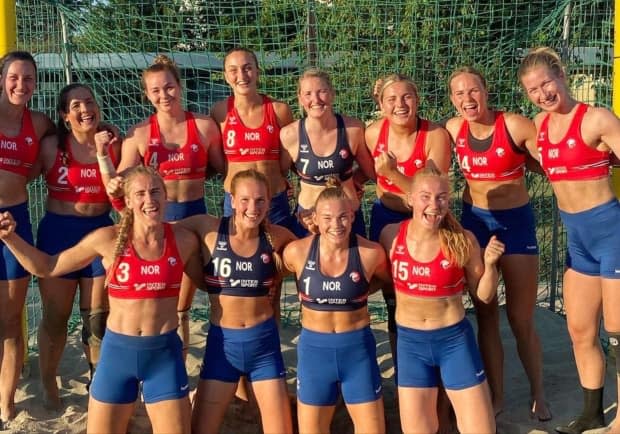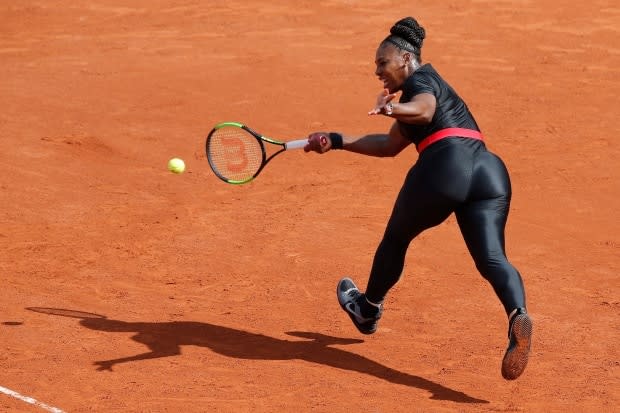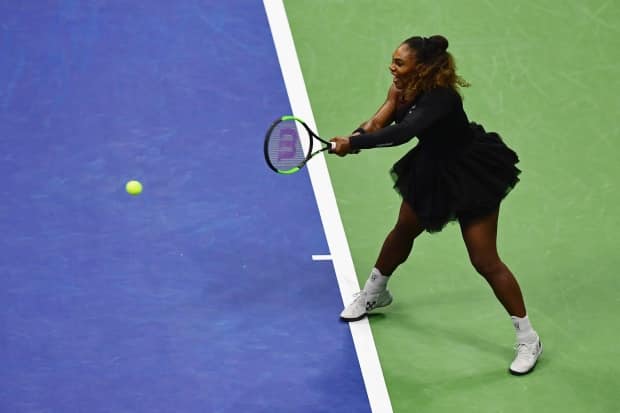Women athletes are pushing back against the uniform status quo

In a number of recent incidents that have made news around the world, women athletes are pushing back against restrictive standards for competition clothing.
During the European Beach Handball Championships on July 18, the Norwegian women's beach handball team was fined for eschewing the sport's typical bikini bottoms, instead opting for shorts.
And on July 25, the German women's gymnastics team wore ankle-length unitards (instead of the usual bikini-cut leotards) during qualifiers for Olympic competition.
The pushback signals a turning point for women athletes who are taking control of their image on the international stage.
Recent incidents in international sports, including Olympics
The Norwegian women's beach handball team paid a $1,764 US fine for being improperly dressed, handed down by the European Handball Federation, Europe's governing body for handball.
The country's sports minister, Abid Raja, called the punishment "completely ridiculous." It then gained wider cultural traction when pop singer P!nk offered to pay the fee for the team.
That these changes are happening in the public eye is a positive thing, said Angela Schneider, an Olympic medallist in rowing and the Director of the International Centre for Olympic Studies at Western University in London, Ont.
"When you have somebody like a pop star like P!nk step up and say, 'I'm gonna pay for all those fines for those Norwegian handball gals,' that's [a] big statement," Schneider said.
"It's a woman — it's a wealthy woman — and she's saying, 'You know what: I'm going to stand up for other women.'"

Tennis superstar Serena Williams was criticized by Bernard Giudicelli, president of the French Tennis Federation, for wearing a sleek black catsuit during the 2018 French Open as a way to regulate blood clotting.
After Giudicelli stated in an interview that catsuits would be banned from future competitions, Williams donned a black tutu for her next match, at the U.S. Open.
It was a major cultural moment that reverberated beyond the sports world, calling attention to the scrutiny that women athletes face.

That contrast was amplified again on July 18, when Paralympian Olivia Breen was competing at the England Senior and Disability Track & Field Championships in Bedford, U.K., and a woman competition official remarked that her shorts were "too short and inappropriate."
"I was left speechless," Breen wrote in a statement posted on Twitter. "I have been wearing the same style sprint briefs for many years and they are specifically designed for competing in."
Both Breen and the Norwegian women's beach handball team wore shorts in competition — but Breen was criticized for exposing too much skin, and the handball team, for not exposing enough.
It's an impossible standard for women in the international sports spotlight, Schneider said.
"The common thread here between the two things are: it's about empowerment, women deciding what's appropriate for them, and the double-bind is based on societal ... expectations of women, and everybody judging and making this fight on the backs of women's bodies," she said.
Women athletes often sexualized for TV ratings: former Olympian
While these incidents aren't confined to the Olympic Games, women athletes have been sexualized during Olympic competitions for decades, with clothing and media coverage designed to attract eyeballs, Schneider said.
"This has been a long time coming," said Schneider. "Because even in my time, competing as an athlete many years ago … there were a lot of questions by some of the women about some of the uniforms."
She said that sports associations justified sexualized competition clothing as a way to attract financial support and keep viewership ratings up, with media coverage often focusing on women's figures and not their performance.

Television ratings are indeed a factor. In 2011, the Badminton World Federation was criticized for a dress code that made women athletes wear skirts or dresses. In an interview with the New York Times, the head of the federation said, "TV ratings are down … We want [the women athletes] to look nicer on the court and have more marketing value for themselves. I'm surprised we got a lot of criticism."
That thinking clearly "objectifies the women and their bodies," said Schneider, putting the focus on that "and not on their athletic abilities."
"The coverage of the men would be of the powerful spike they did, say, … in beach volleyball," she said. "And the coverage of the women is a shot of their butt from behind."
Carol-Angela Orchard, a gymnastics coach with the Canadian national team for 30 years, said that while gymnasts are training, they rarely wear the same style clothing that viewers see on television during formal competitions.
"They always have a pair of shorts on," she said.
She further pointed out that the gymnastics world is still recovering after it was revealed that disgraced U.S. gymnastics team doctor Larry Nassar sexually assaulted hundreds of patients over the course of his career. Nassar was sentenced to 60 years in prison in 2017.
"Most athletes don't feel completely comfortable in a leotard, but it's something they've always had to put up with," Orchard said.
Allison Sandmeyer-Graves, the CEO of Canadian Women in Sport, a non-profit organization that aims to advance equity for women in and through sport, said that the messaging is puzzling for women and girls who take in media coverage of women athletes.
"You can appreciate how confusing this is for women and all the girls who are watching and paying attention to these stories," Sandmeyer-Graves said. "How do you navigate that terrain when there's so many people with an opinion about how your body should look and really policing what you wear and how you appear when you're playing sports?"
Athletes should have more of a say in uniforms: experts
At the international level, rules for competition clothing are set by international governing bodies. In Canada, a National Sports Organization (NSO) is typically responsible for uniform regulations at the national level.
But Schneider said it's time to give athletes more of a say in what kinds of clothing they perform in.
"There's all kinds of sports uniforms, and sports companies designing all kinds of different things; from women who need to ... wear something closer to a hijab, or women who, like the Paralympian [Breen], who want to wear what is standard issue for that particular sport," she said.
Administratively though, she added, providing more choice is costly and requires more work.
Orchard, who worked as a beam specialist with the German women's team, said that her job was to prepare gymnasts to "be comfortable being uncomfortable."
"I think people like the German team [are] taking those risks and pushing forward and trying to make sure that they're making choices that are in the best interests of women, not just men," she said.
WATCH | German Olympic gymnastics team push for a wardrobe revolution:
"Some athletes don't put rhinestones at the top of their sleeves because, when their arms are up by their ears on bars and they land in that position, it scratches them," Orchard added. "Other athletes don't feel that at all in it. They like lots of sparkles.
"So it really does just come down to choice — and empowering them to make the decision that really works best for them."

